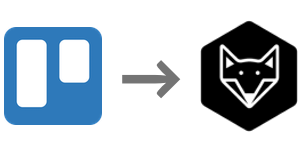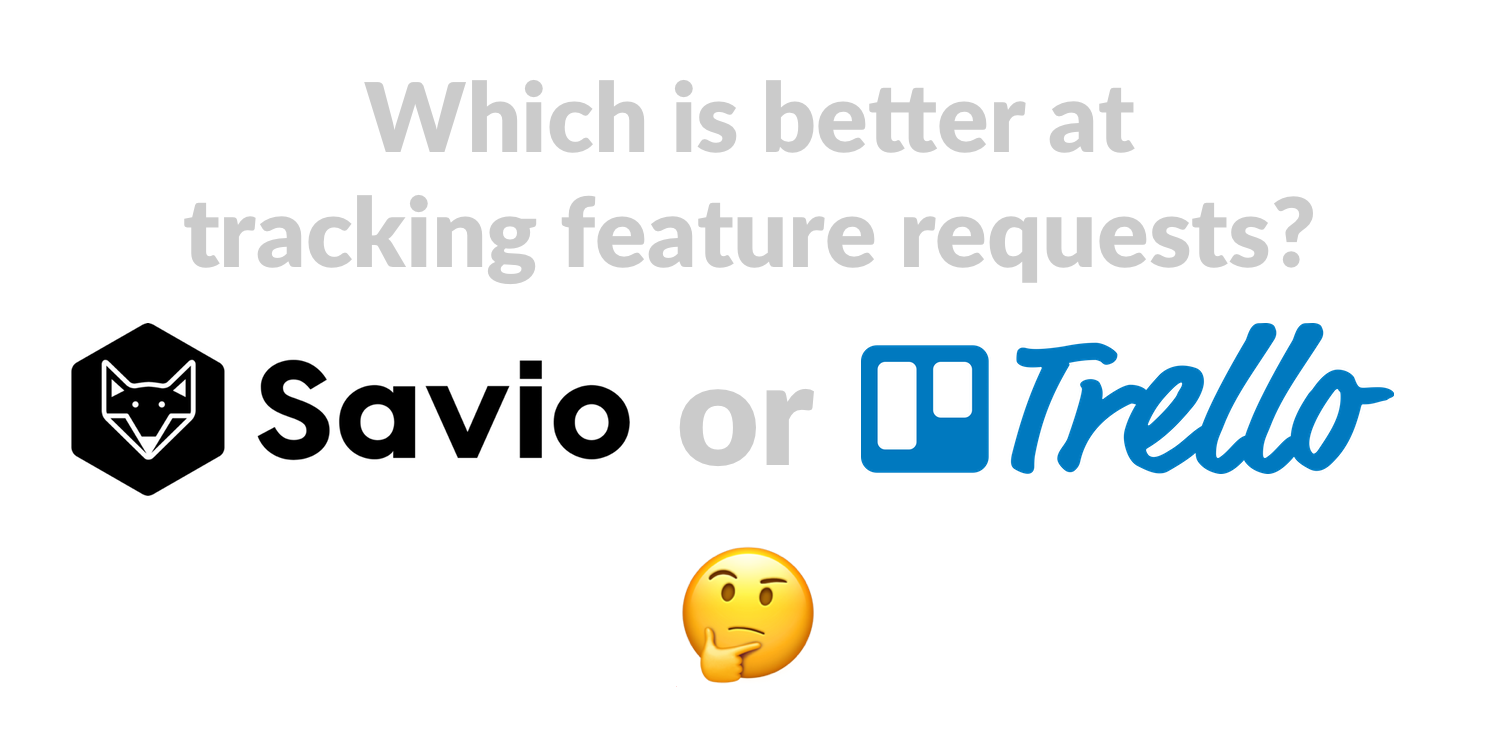
The best alternative to Trello to Track Feature Requests
Trello vs Savio: how they compare
Summary
- Choose Trello if you don't mind doing manual work to cut and paste between your different sources of feature requests, or you want a public voting board or a customer facing roadmap, and if a free tool is important to you
- Choose Savio if you want native integrations that makes tracking features from Intercom, Help Scout, or Slack easy, want to segment feature requests by user and account properties (like MRR and Plan), want to close the loop with customers, and don't mind paying some money to save time
- Read on for the full comparison
Centralize feature requests from all your tools
|
|
Good |
|
|
Not Good |
Savio
Savio centralizes feature requests from any place your team receives them. You can track feature requests received in Intercom, Help Scout, or posted in Slack. You can use a Chrome Extension to track feature requests in any other web-based tool that your team uses (like a CRM). You can send feature requests in via email, send feature requests from any tool via Zapier, or use an API to track feature requests. Each of these minimizes disruption when your support or sales teammates need to track feature requests.
Once centralized, you can prioritize your features knowing they're all in one place.
Trello
Centralizing your feature requests from different tools in Trello involves a lot of cutting and pasting. The easiest way is to:
- Have each Trello card represent a feature
- Paste the link to the source conversation in the Trello description
- Put the number of requests in the card's title so you can see how many requests each Feature has when you're looking at all the cards
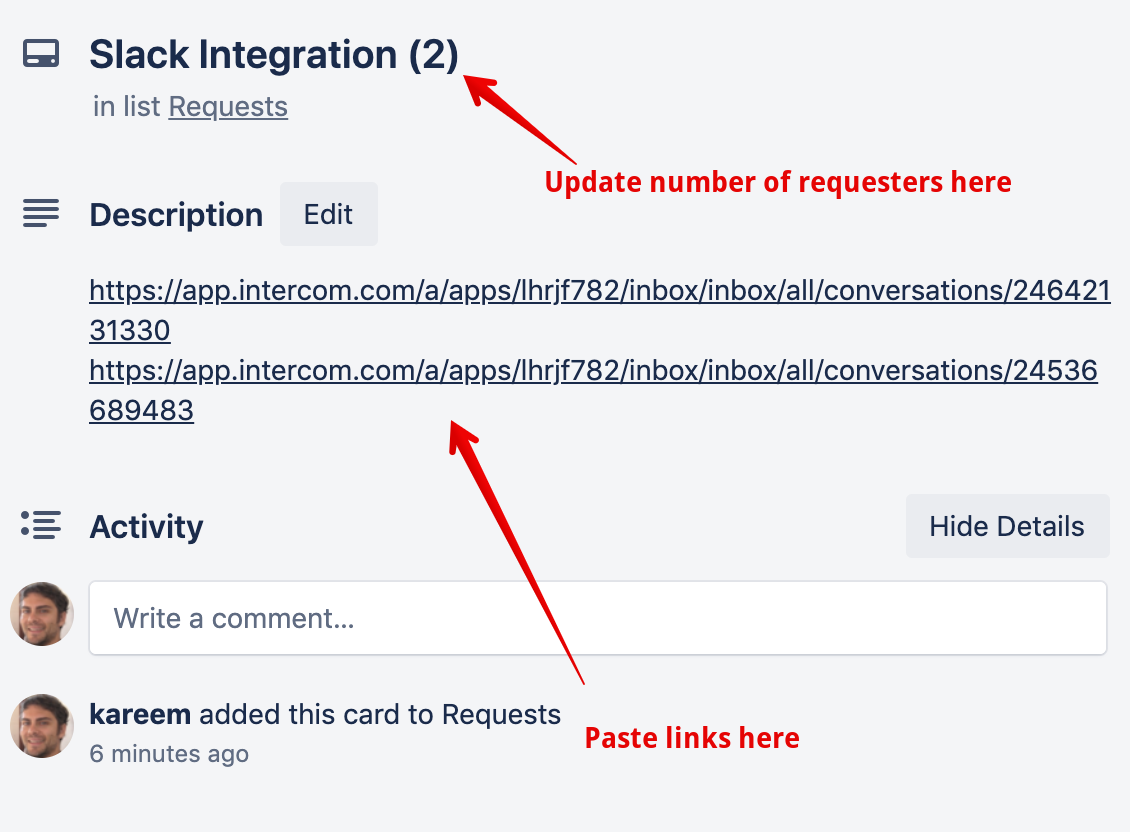
The main downsides of this approach are:
- You and your team needs to cut and paste from each tool, which makes it less likely to happen
- To understand the nuances of a feature you need to open several different tabs to read what customers wrote in the source tool (support tool, CRM, etc)
- It treats each customer's vote as equal, and doesn't take into account their plan, MRR, or other attributes
Collect Feature Requests From Any Web-Based Tool
|
|
Good |
|
|
Not Good |
Savio
You can track feature requests from any tool with the Savio Chrome extension. This means that your teammate is able to stay in their support tool, CRM, etc when they send feature requests to Savio. Just click the Chrome Extension, enter details about the feature request, and you're done. You don't have to switch tools or tabs: minimal disruption.
Savio's Chrome Extension ensures your teammates will track more feature requests because it's lower friction than cutting and pasting between different tabs.
Trello
Since Trello has no native integrations, tracking features from other tools gets complicated. To track a feature request, your sales, success, or support team has to be bought into the process. Assuming you can get buy-in from your other teams, your teammates must have both tools open in two different windows, and will have to cut and paste between the two windows to track a feature request in Trello.
Automatically import customer data
|
|
Good |
|
|
Not Good |
Savio
Since not all feedback is equal, Savio tracks WHO requests a feature. If you don't know details about who requested a feature, you're basing key decisions on things like number of upvotes. You can't query for "all feature requests from Enterprise customers" or "feature requests from churned customers" or "feature requests from customers paying $300/m or more" like you can in Savio.
Savio can import customers, accounts, and related properties like MRR, Plan, and any other attributes you care about. You can import your list of customers and properties from Segment, from Intercom, or from Help Scout. It's just one click to import and to stay in sync as new customers join your app and their properties change.
Trello
Trello has no notion of a "customer". Which means all feature requests are treated equally. You can't segment feature requests by customer or account info like MRR or Plan. You also can't easily reach out to customers to validate problem and solution, or to tell them you built what they asked for.
Collect feature requests from Help Scout
|
|
Good |
|
|
Not Good |
Savio
Savio has a native integration that allows you to track feature requests from Help Scout. When your support team gets a message with a Feature Request, they just add a predefined tag to the conversation. Savio will then pull the feature request in. Savio will also add a private note to the Help Scout Conversation to confirm that it's pulled the feature in. This means your teammates don't need to leave Help Scout to track feature requests in Savio, nor do they need a Savio account.
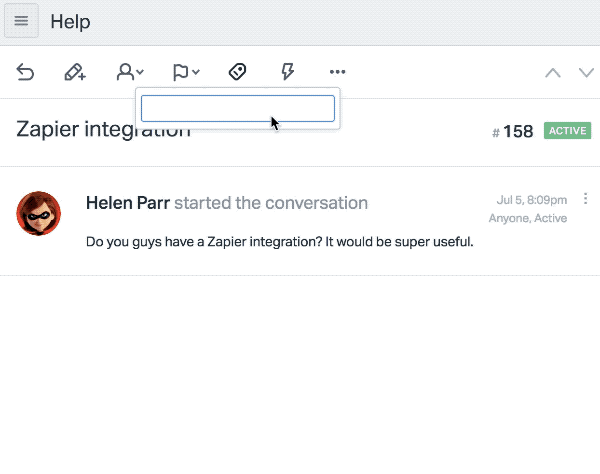
Trello
Trello doesn't have a Help Scout integration. So tracking feature requests from Help Scout in Trello is a manual process involving cutting and pasting.
Collect feature requests from Intercom
|
|
Good |
|
|
Not Good |
Savio
Savio has a native integration that allows you to track feature requests from Intercom. Similar to tracking feature requests in Help Scout, when your support team gets a message with a Feature Request, they just tag the messsage with a predefined tag for Savio to slurp the feature request in. Savio will also add a private note to the Intercom conversation to confirm that it has the feature request. This means your teammates don't need to leave Intercom to track feature requests in Savio, nor do they need a Savio account.
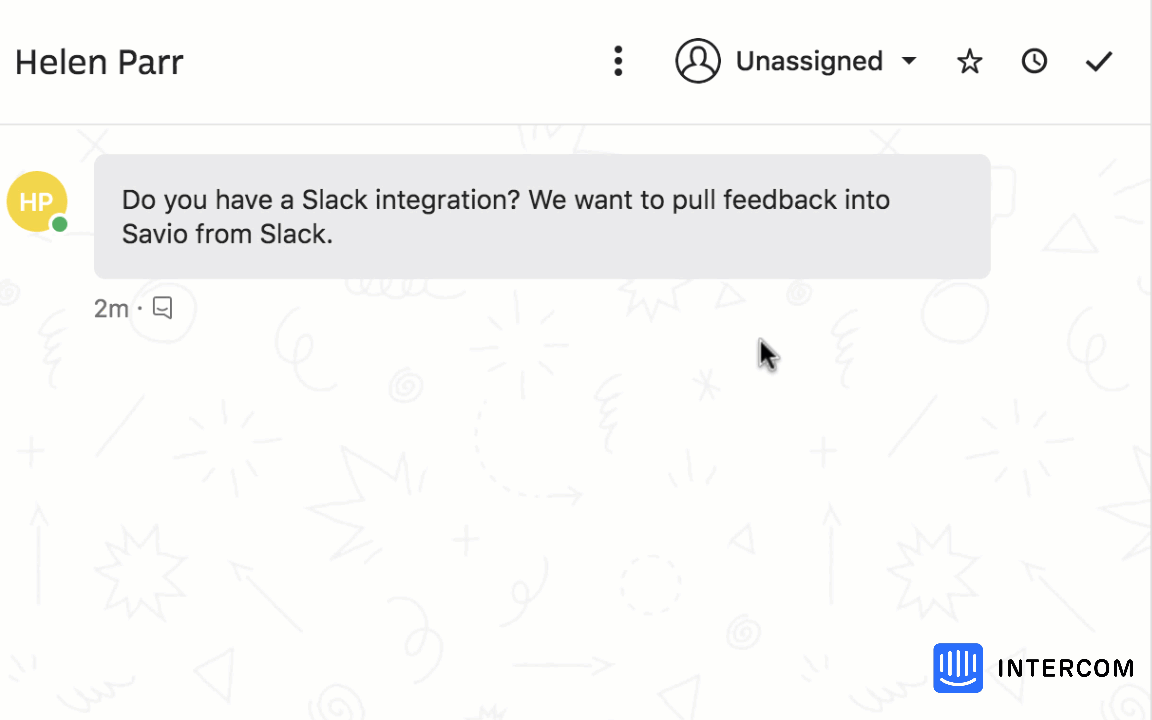
Trello
Trello doesn't have an Intercom integration. Tracking feature requests sent to Intercom using Trello involves a lot of cutting and pasting.
Collect feature requests from Slack
|
|
Good |
|
|
Not Good |
Savio
Savio has a native integration with Slack. With it you can collect feature requests from Slack and send them to Savio with the click of a button. So when your teammates share feedback or feature requests from customers in Slack, those feature requests won't be lost. They'll be centralized with feature requests from other tools, and you can use them later on to prioritize what features to build.
Trello
With Trello there's no straightforward way to track feature requests shared in Slack.
Collect feature requests via Email
|
|
Good |
|
|
Good |
Savio
When product feedback hits your inbox, you can email it directly to Savio. Savio will pull out the name and email address of the person who sent YOU the feedback. And it'll land in your Savio inbox, ready for you to triage it.
Trello
You can email feedback directly to your private Trello email address. When you do, it appears in a Trello list for you to triage later.
Has feedback triage process
|
|
Good |
|
|
Not Good |
Savio
You've heard of the phrase garbage in, garbage out? Triaging ensures your feature request list quality stays high and you can base your decisions on vetted feedback.
When feedback is sent into Savio, it lands in your feedback inbox. Somebody on your team should triage your product feedback regularly. Triaging means assigning a customer, choosing a feature request for the feedback, and determining whether the feedback was from an active customer, a churned customer, a lost deal, a prospect or a teammate.
This triage step means that every bit of data in Savio that you're going to base your valuable and important prioritization decisions on will have been vetted by somebody on your product team.
Trello
The easiest way to use Trello is without a Triage step: your success team opens Trello, finds the card that represents a feature request, and adds a link to a new conversation to it. There is no triage step, which means there's more noise and less signal. So when you're making decisions about what to build next, you'll be basing your decisions on data that has not been vetted by your product team.
Now, you can use Trello with a Triage step, but it makes it harder to do. All feedback would go into a single column, and then you'd triage feedback and move requests to existing Trello cards (or create new ones if they were new Feature Requests). Note that sending feedback intro Trello by email forces this behavior - all emailed feedback ends up in a single Trello column.
Segment feature requests from customers you care about
|
|
Good |
|
|
Not Good |
Savio
Some customers are simply more valuable to your business. Customers in your ideal customer profile are ones that you want to listen to more than others.
So when prioritizing, you often want to focus on building features for a certain set of customers.
Because Savio imports your customers, their MRR, their plan, and any other custom attributes you care about, you can segment your feature requests by plan, MRR, or by any of those attributes.
Savio respects that all customers and all feedback are not created equal. Prioritizing based on number of requests is useful, but coarse. You probably want to prioritize for what actually matters to the customers you care about.
Trello
Trello does not have the notion of a customer or attributes. The only way you can segment features is to label them. And even then, it's impossible to run queries like you can in Savio to see "feature requests from churned customers" or "feature requests from customers on our Enterprise plan".
Public or private voting portal
|
|
Not Good |
|
|
Good |
Savio
Savio does not have a public place where customers can see and vote on feature requests.
Trello
Trello has a voting portal that can be public or private.
The advantage of having a portal is that you get feedback without anybody on your team needing to handle it.
There are a few downsides to having a portal. Here are the main ones:
- Customers can get frustrated that you haven't built a feature ("This feature has been open for three years, why haven't you built it yet?!")
- It gives your competition ideas about where your product is weak
- it over-indexes for the "squeaky wheels". Are the people who leave feedback really representative of your customer base as a whole?
If a public voting portal is what you're after, Savio's probably not the right fit for you.
Customer-facing roadmap
|
|
Not Good |
|
|
Good |
Savio
With Savio, there's no public roadmap option. Of course, you have the option to share what you're building privately with customers.
Trello
Trello gives you a public roadmap to share with your customers.
The two big downsides to sharing your roadmap publicly are:
- Competitors can see what you're planning and working on
- Priorities change so you can set the wrong expectations with customers
If it's important to you to have a public roadmap in the same tool that you track feature requests, Savio might not be the right fit.
Close the loop with customers
|
|
Good |
|
|
OK |
Savio
When you build a feature that a customer asked for and let them know, it's usually thrills them. It shows you care about solving their problems AND letting them know you solved it. Closing the loop is one of the best things you can do for customer loyalty.
Closing the loop in Savio is easy. When you click on a feature, you'll see each person that asked for it. You can either contact each person from there via email, or you can click through to the original Help Scout, Intercom, or other conversation thread where you first received the feature request.
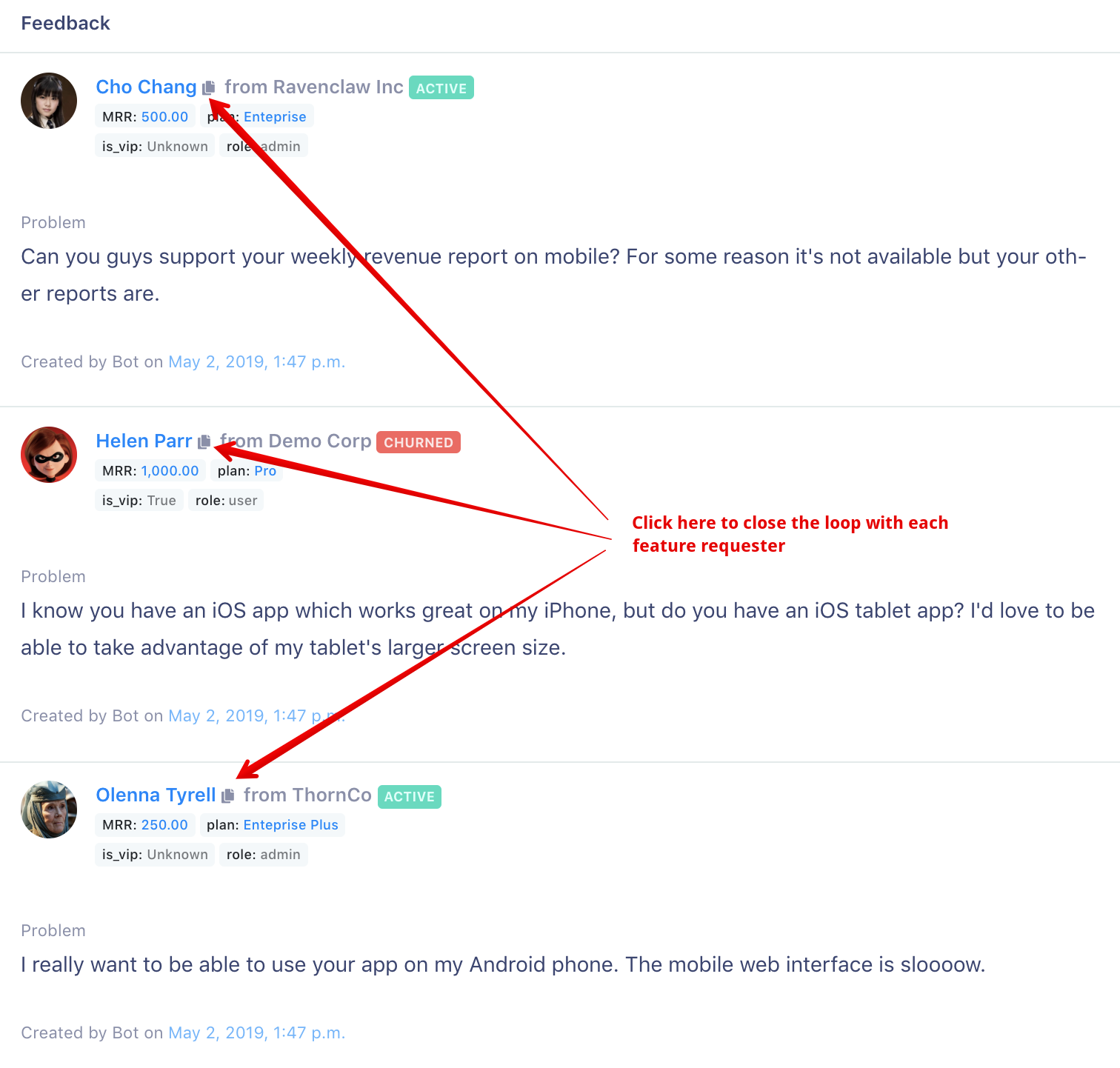
Trello
Trello doesn't keep track of a user's email address or where a feature request was first captured. If you save links to where your feature requests are received, you can open a Trello card and click each link to close the loop with them. If you don't take this approach to tracking feature requests in Trello, it'll be more difficult to close the loop with them.
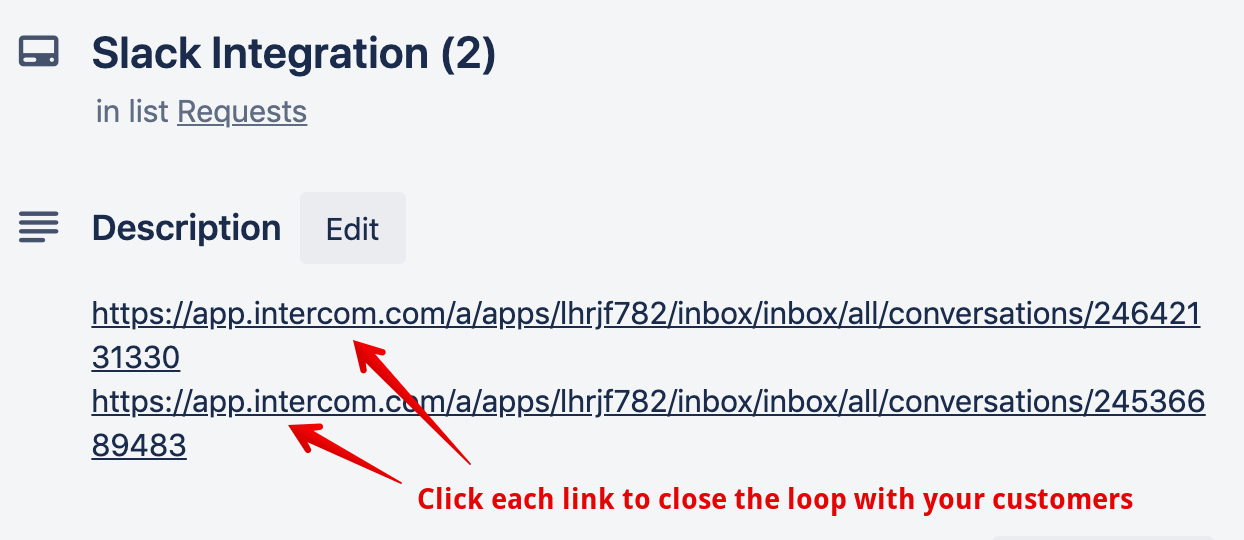
See detailed feedback for every Feature Request
|
|
Good |
|
|
Not Good |
Savio
With Savio, when you click on a feature request you'll see:
- everybody who asked for that feature
- each customer's exact words they used when they asked for the feature
- their company, MRR, plan, and any other customer attributes you've sent in
- whether they're churned, active, a lost deal, a prospect, or a teammate
- And you can even click through to the source tool where the feedback came in from.
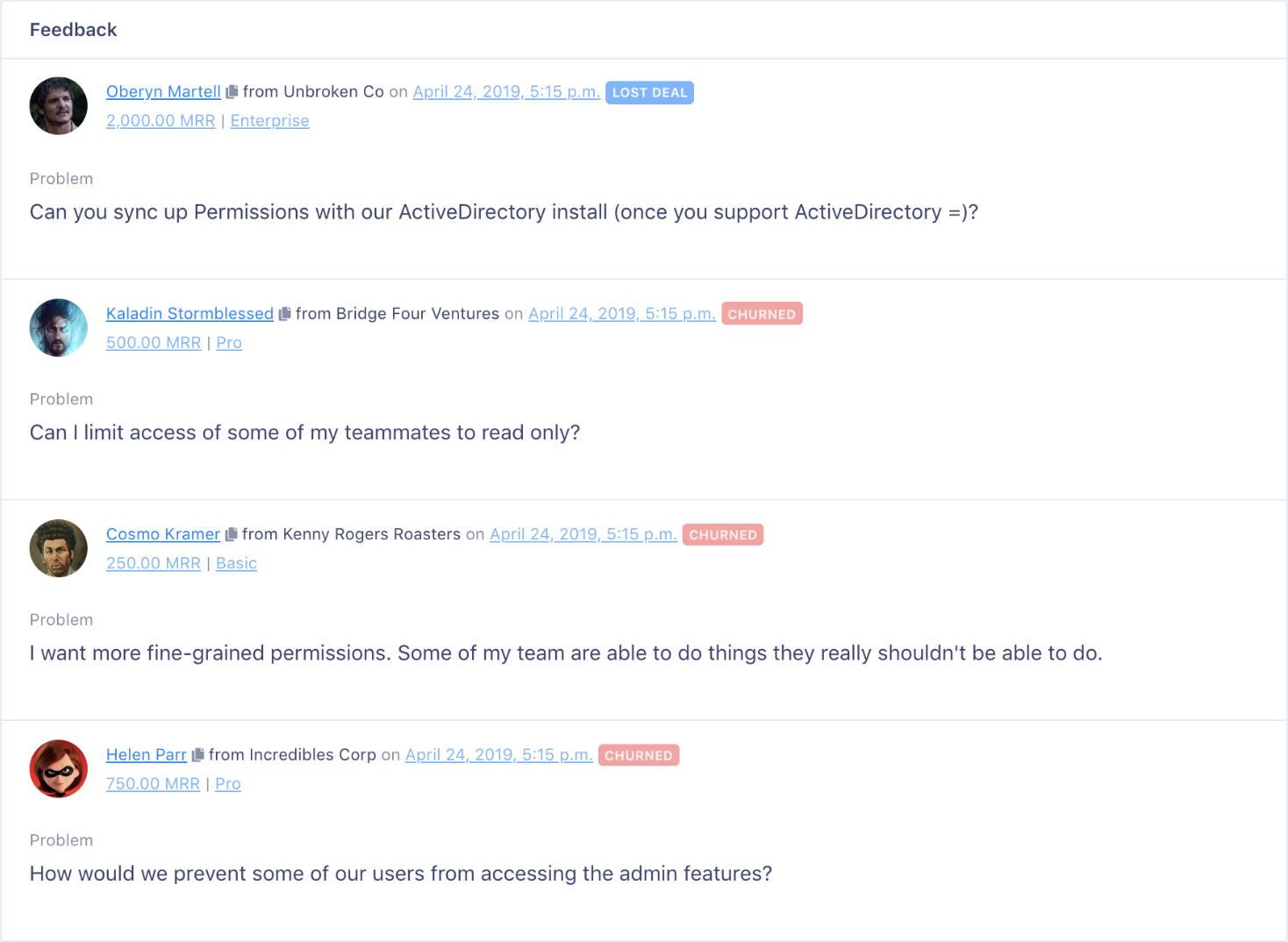
Trello
In Trello, what you see when you view a Feature Request will depend on how you use it. You may see a list of links to (for example) Help Scout conversations. You may see cut and pasted customer feedback. Since Trello is configurable any way you want, it's up to you to figure out how you want to track features and stay consistent. But you definitely won't get as much context about who requested features or the nature of their feature request in Trello as you would with Savio.
Easily reach out to customers that provided feedback
|
|
Good |
|
|
Not Good |
Savio
In Savio, you can easily reach out to customers that have asked for a specific feature to better understand their problem and validate your solution. Every user's email address is on the page that describes your feature request.
Trello
Since Trello is configurable it's up to you whether you want to cut and paste a user's email address in addition to their feedback, or whether you want to just save a link to a (for example) Intercom conversation, or whether you just want to +1 a feature with no other context. So in theory it possible to save email addresses of your requesters to reach out. But that will take discipline when you save feedback.
Import users without adding and customizing Javascript
|
|
Good |
|
|
Not Good |
Savio
In Savio, you can import users without adding custom JavaScript to your site. This means that you can import customers without needing a developer. You can either import your users from Intercom or you can import your users from Segment, just by clicking a few buttons. You can get up and running in seconds rather than hours or even days.
Trello
Since Trello does not have the notion of a user, you can't track who left feedback for a feature without manual work.
Designed for collecting feedback
|
|
Good |
|
|
Not Good |
Savio
Savio is purpose-built for tracking and prioritizing feature requests. It helps with the jobs and workflows to solve that problem: you need to collect feedback, bucket it into feature requests, prioritize requests, track features through the planning lifecycle, reach out to requesters to validate problem and solution, and close the loop with them once built.
If you're interested in a tool that focuses on providing a simple mechanisms to capture your customer feedback and use it to figure out what features to build next, Savio is probably a great fit.
Trello
Trello is a general-purpose tool that you can use for lots of things. Tracking features is one of them. Since Trello doesn't give you "guard rails" to ensure you and your team regularly walk the "happy path" when tracking features, it takes discipline on behalf of your whole team to ensure you're consistent about tracking your requests. For example, you need to define a way to track your requests. You need to be diligent about copying and pasting requests in the right format. And since tracking in Trello is a highly manual process, you need to be diligent about tracking in the first place!
Additionally, since Trello is a general purpose tool, there are just some things you can't do with Trello that you can do with a purpose built tool. For example, you can't segment your list of feature requests by Plan or MRR (or other attributes). You won't get a daily summary email of all new tracked feature requests.
And if you're using Trello as a private way to track features, you can't see something as important as the number of people who want a feature when you're looking at your list of features (unless you're diligent about tracking it manually).
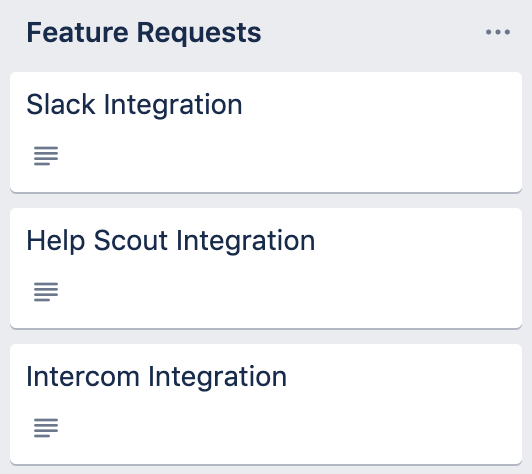
Export your data to CSV
|
|
Good |
|
|
OK |
Savio
With Savio, it's straightforward to export your data to a CSV. You just click a link and you'll be emailed a CSV within minutes containing all of your feature requests, customer feedback, name, email address account, MRR, Plan, tags, etc. It's your data and you should be able to take it out whenever you want.
Trello
With Trello you have to upgrade to a paid plan to export your data to a CSV.

Can users provide feedback without logging in
|
|
Good |
|
|
Not Good |
Savio
Since Savio doesn't have a public voting portal, when a customer sends feedback to support, your rep can send that feedback directly to Savio. The customer doesn't need to login or create an account for a tool they don't have a relationship with (e.g. Trello).
Trello
When a user wants to leave feedback publicly with Trello, they must create a account in order to vote or leave feedback:
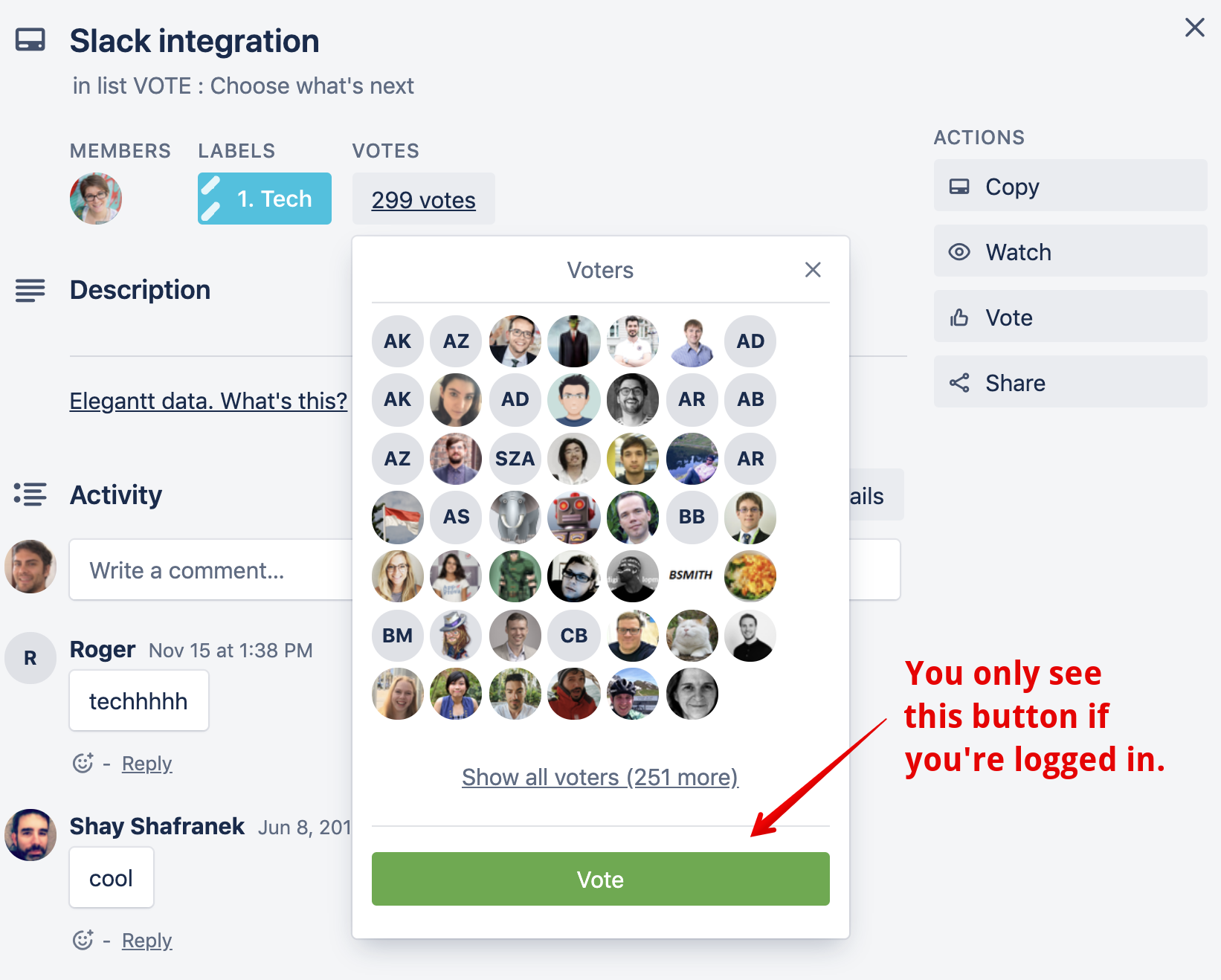
If your customers aren't logged into Trello, there's no way for them to know that they can upvote a feature since there's not even a callout to log in to upvote.
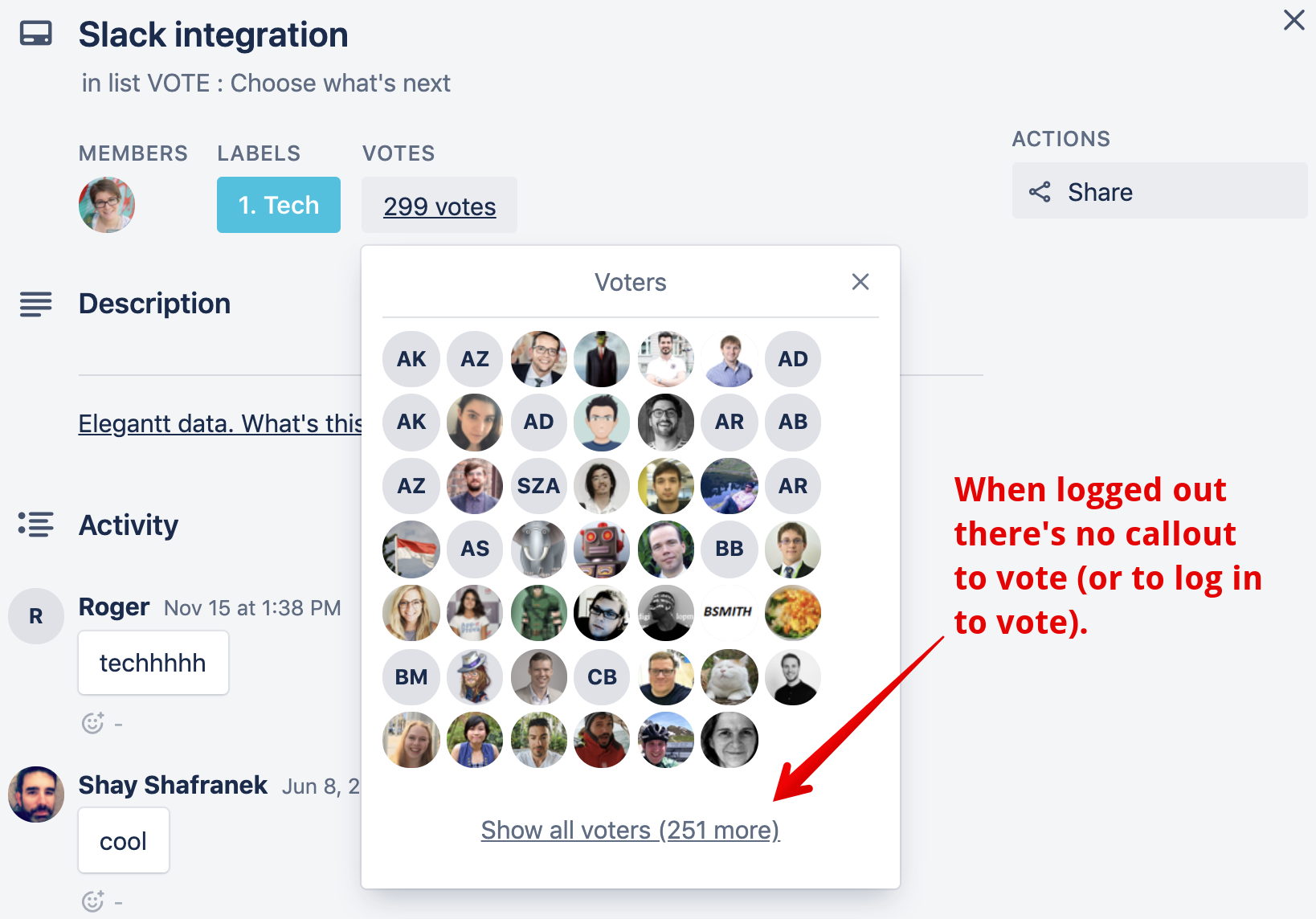
Track requests from users at different points in customer journey
|
|
Good |
|
|
Not Good |
Savio
With Savio, you can track when a feature request comes from a churned user, active user, lost deal, prospect, or teammate.
So when you're trying to reduce churn you can see all feature requests from churned customers, and then build some of them. Or if you're trying to lose fewer deals, you can build features from lost deals. This information is entered when a feature request is captured, so there's no technical integration necessary.
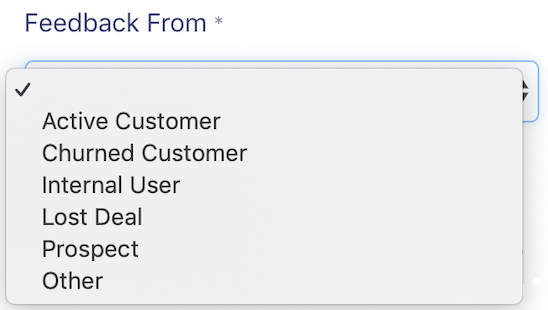
No technical integration necessary.
Trello
There's no way to determine what point a customer is at in their journey with your app when they leave a feature request. Which means it's impossible to see things like "feature requests from churned customers" or "feature requests from active customers".
Users are first-class citizens
|
|
Good |
|
|
Not Good |
Savio
Savio respects that users make feature requests. Users belong to accounts, and have properties that you may want to segment your feature requests by (like MRR and Plan). You may want to contact users, so Savio displays their email addresses for you.
Trello
A user in Trello consists of a name and company name. Users don't have properties and you can't contact them.
Record customers' actual words about problems, not just votes
|
|
Good |
|
|
OK |
Savio
In Savio, you can record and see the actual words that a customer used to describe their problem. Additionally, each piece of customer feedback is a vote for a feature. So you get BOTH votes AND actual customer words.
Trello
With Trello, you get votes and users can leave comments. But you often get a wide spread between the number of votes and the number of comments.
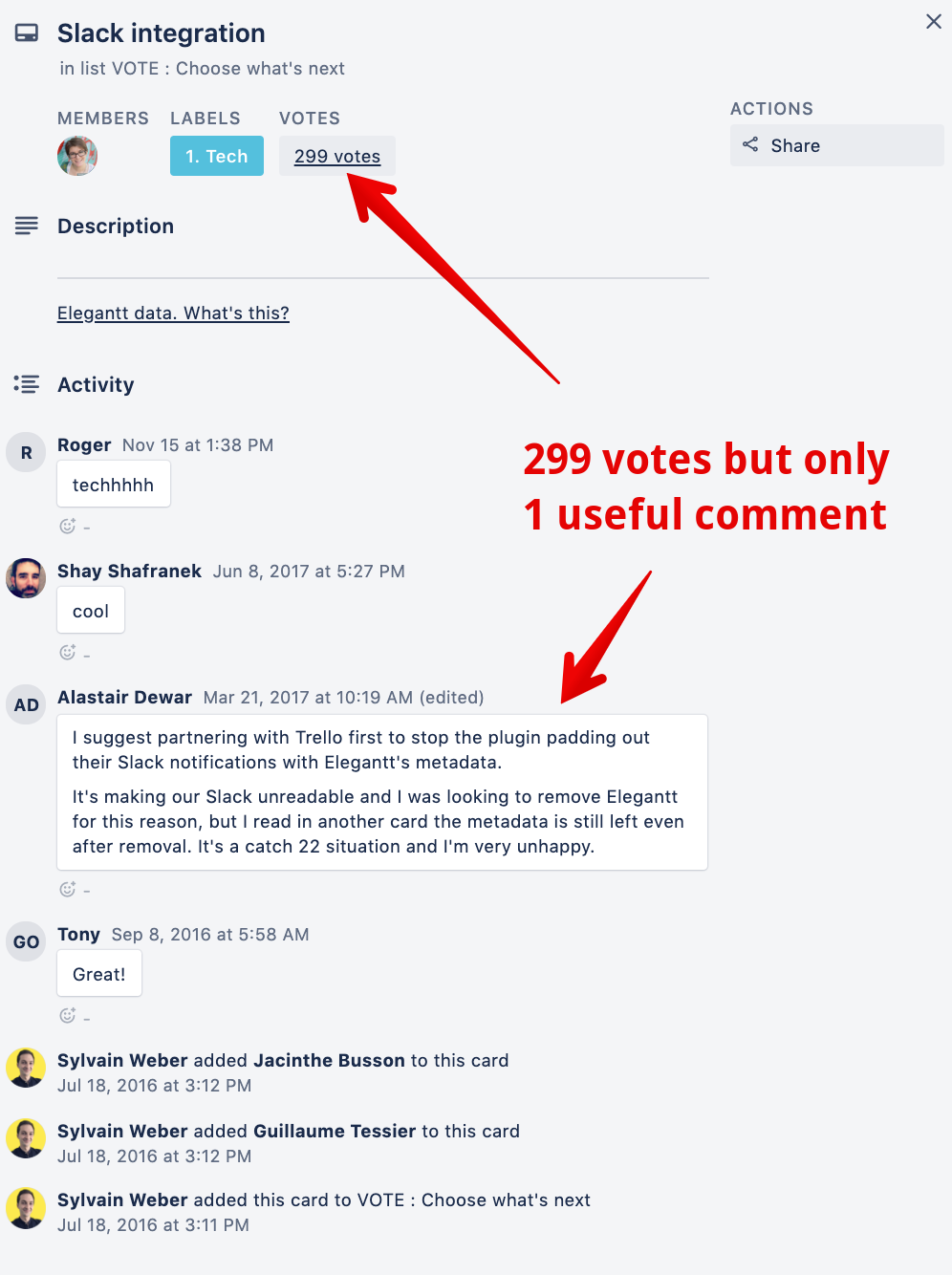
It can't be understated how important it is to have customers' words instead of just upvotes to make good prioritization decisions. A customers' words help you understand the context and boundaries of the problem to build a good solution.
Friendly Support
|
|
Good |
|
|
OK |
Savio
Savio is run by Ryan Stocker and Kareem Mayan. We're two developers-turned-product managers-turned-founders who've been building software since 2001. We're also the people who answer your support requests!
We built Savio, and we know how it works inside and out. Which means we can write code ourselves to fix the problems that you have. We care passionately about making sure that you're successful, because if you are successful, we're successful. You're not just another number who's going to get support from somebody who's five levels away from the CEO or three levels away from the developers and whose requests have to go through a product team to be prioritized.
Trello
Trello is owned by Atlassian, a large company with a large support team. Support is friendly, but given the people answering your support requests aren't the people writing code, you'll probably have to wait longer to get your problems solved. Especially if you're not a paying Trello customer.
Can your sales and support team capture feedback without leaving their tools?
|
|
Good |
|
|
Not Good |
Savio
With Savio there are two ways that you can capture feedback from an existing tool. One is with a native integration with Help Scout, Intercom, or Slack. If you're using one of those tools, your teammates do not need a Savio account and they don't need to leave the support tool or CRM. They just add a tag and move on with their life. If you get feedback in other tools, your teammates can use the Chrome Extension to send relevant feature requests to Savio without leaving the tool where the feedback arrived.
These two approaches mean your team's workflow is barely (or not at all) disrupted, and it increases the liklihood that you'll capture good quality feature requests.
Trello
With Trello there's no avoiding the fact that there will be a lot of cutting and pasting between the support, success, or sales tools and Trello. This is a more disruptive workflow for your teammates.
Daily email digest of new feature requests
|
|
Good |
|
|
Not Good |
Savio
You get a daily email and that shows you all the new feedback and all the new feature requests that were received in the last 24 hours. It's easy to keep your finger on the pulse of your new feature requests when they hit your inbox every day.
Trello
In Trello, you can't get notifications about new cards that are added or when card descriptions are updated. Which means you're flying blind in terms of getting updates about what new feedback and feature requests you're getting.
How Savio and Trello Compare
Import your Trello Data
Looking to switch from Trello? We'll import your data for free.
